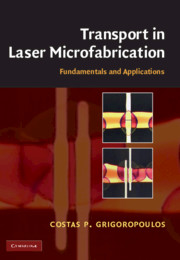Book contents
- Frontmatter
- Contents
- Preface
- 1 Fundamentals of laser energy absorption
- 2 Lasers and optics
- 3 Thermal processes in laser–materials interactions
- 4 Desorption at low laser energy densities
- 5 Dynamics of laser ablation
- 6 Ultrafast-laser interactions with materials
- 7 Laser processing of thin semiconductor films
- 8 Laser-induced surface modification
- 9 Laser processing of organic materials
- 10 Pulsed-laser interaction with liquids
- 11 Laser cleaning of particulate contaminants
- 12 Laser interactions with nanoparticles
- 13 Laser-assisted microprocessing
- 14 Nano-structuring using pulsed laser radiation
- Index
- References
11 - Laser cleaning of particulate contaminants
Published online by Cambridge University Press: 04 December 2009
- Frontmatter
- Contents
- Preface
- 1 Fundamentals of laser energy absorption
- 2 Lasers and optics
- 3 Thermal processes in laser–materials interactions
- 4 Desorption at low laser energy densities
- 5 Dynamics of laser ablation
- 6 Ultrafast-laser interactions with materials
- 7 Laser processing of thin semiconductor films
- 8 Laser-induced surface modification
- 9 Laser processing of organic materials
- 10 Pulsed-laser interaction with liquids
- 11 Laser cleaning of particulate contaminants
- 12 Laser interactions with nanoparticles
- 13 Laser-assisted microprocessing
- 14 Nano-structuring using pulsed laser radiation
- Index
- References
Summary
Introduction
Effective contamination control and development of an efficient cleaning technology are critical in the semiconductor-device manufacturing and data-storage industry (Mittal, 1988). Especially, sub-micrometer-contaminant removal is becoming more and more important as tighter microscale integration of devices is constantly being pursued in the industry. The most effective way to solve the contamination problem is to avoid contamination by adequate design of a manufacturing process based on careful analysis of the contamination sources. However, in many cases, the process itself is a source of contamination and the development of a cleaning tool may often be unavoidable. In fact, a large percentage of the fabrication cost is attributed to several elaborate cleaning steps. Several conventional cleaning techniques are currently in wide industrial use. Nevertheless, laser cleaning (LC) is attractive because of the following advantages over the conventional cleaning techniques.
It is effective for sub-micrometer- to macroscopic-sized contaminants.
The cleaning process is environmentally sound, not involving bulk usage of toxic solvents.
The chance of causing mechanical damage to delicate parts is relatively small.
Selective cleaning of a part is possible through search-and-clean procedures.
Much research work has been done on LC schemes for a variety of substrates since the 1980s. A few notable examples of earlier work should be mentioned. Zapka et al. (1989) demonstrated LC applied to the cleaning of electron-beam-lithography masks (delicate Si membranes of thickness just 3 μm with transmission apertures of dimensions about 1 μm); such structures are too vulnerable to damage or contamination if cleaned by conventional megasonic techniques, scrubbing/wiping, high-pressure jets or other means but were found to be effectively cleanable simply by irradiation with a few ultraviolet (UV) laser pulses at a wavelength of 248 nm and energy fluence typically lower than 0.3 J/cm2.
- Type
- Chapter
- Information
- Transport in Laser MicrofabricationFundamentals and Applications, pp. 313 - 329Publisher: Cambridge University PressPrint publication year: 2009

